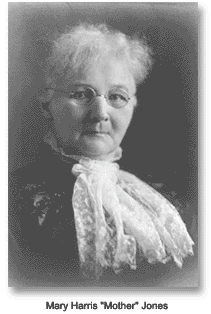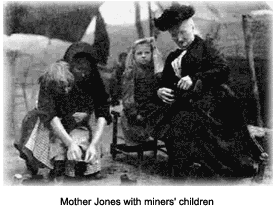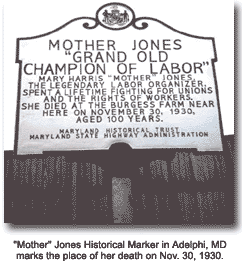Born on August 1, 1837, to past generations of freedom fighters in Cork, Ireland, Mary Harris Jones was known as the "white-haired `Mother` Jones" of the labor movement, from 1880 through the early 1920s. Jones is best known for her struggles to win decent living and working conditions for the United Mine Workers, and her participation in the Haymarket Day demonstration for the eight-hour day movement in Chicago in 1886.
 Richard Harris, Jones` father, came to the United States in 1835, and after receiving citizenship, set about bringing the rest of his family to this country. His work as a laborer on the railway construction crews took him to Toronto, Canada, where Jones was reared.
Richard Harris, Jones` father, came to the United States in 1835, and after receiving citizenship, set about bringing the rest of his family to this country. His work as a laborer on the railway construction crews took him to Toronto, Canada, where Jones was reared.
After receiving her teaching certificate in Toronto at age 20, Jones landed a position at a convent in Monroe, Michigan. She taught there for eight months, after which she moved to Chicago, Illinois, where she became a dressmaker.
Jones returned to teaching when she moved to Memphis, Tennessee, where she met and married her husband, George Jones, in 1861. George Jones was an iron moulder and member of the Iron Moulders` Union. During her short marriage, Jones learned about unions and the psychology of laborers, which she later imparted to the wives of laborers. She once said, "The wife must care for what the husband cares for, if he is to remain resolute." The Joneses had four children. Tragedy struck when a yellow fever epidemic broke out in 1867 and everyone in the family but Mary succumbed.
Mary Harris Jones returned to Chicago, where she opened a dressmaking shop. Again, misfortune struck when the great Chicago fire of 1871 destroyed her home, shop and all of her belongings.
While working as a dressmaker, Jones developed an interest in improving the conditions of laborers, after witnessing the disparity between the lifestyle of the “aristocrats of Chicago” and that of the jobless poor walking the streets.
"By 1880," she said in The Autobigraphy of Mother Jones,
"I became wholly engrossed in the labor movement. In all the great industrial centers the working class was in rebellion. The enormous immigration from Europe crowded the slums, forced down wages and threatened to destroy the standard of living fought for by American working men."
While continuing her dressmaking livelihood for another three years, Jones joined the newly formed Knights of Labor, whose members attended meetings to organize strikes against local factory owners. On the evening of May 4, 1886, Jones participated in the Haymarket Day demonstration. The event was named after a little district in Chicago called Haymarket Square, where workers from the McCormick Harvester Works rallied for the eight-hour workday. Ex-convicts were hired by the Pinkerton Agency to control the crowd. Also in attendence was Chicago mayor Carter Harrison, who spoke to the protestors. During one of the speeches, a bomb was set off in the crowd, which killed a number of police officers. Hundreds of people were arrested. Eight leaders were convicted of murder and of those, Albert Parsons, August Spies, George Engel, and Adolph Fischer, were hanged. Seven years later, Governor John Peter Atgeld pardoned Samuel Fielden, Oscar Neebe, and Michael Schwab, who had been serving life sentences.
Jones also participated in numerous other labor uprisings during that time, while traveling all over the country. She became active in the struggles of coal miners in 1890 and became an organizer for the United Mine Workers. She attended the first United Mine Workers of America convention in January 1901. In 1898, she assisted in the formation of the Social Democratic Party, along with trade union activists, such as Eugene V. Debs.
After resigning as a UMWA organizer in 1904, Jones became a lecturer for the Socialist Party of America, which had been formed in 1901 by Debs and other former members of the Social Democratic Party, until her resignation in 1911. She was also among the founders of what was called "one big industrial union," the Industrial Workers of the World (IWW) in 1905. Its preamble averred, "There can be no peace so long as hunger and want are found among millions of working people and the few, who make up the employing class, have all the good things in life."
 Jones received national attention during the Paint Creek-Cabin Creek strike in West Virginia during 1912-1913, due to the publicity of frequent violence there. West Virginia was known for having the highest mine mortality rate in the country between 1890 and 1912. On September 21, 1912, Jones led a march with coal miners` children, and on February 12 she was arrested while protesting the conditions in the strike area. She was arrested and convicted in a military court of conspiring to commit murder, and sentenced to 20 years in prison. She was at least 68 years old and suffered from pneumonia. However, newly elected Governor Henry D. Hatfield pardoned her.
Jones received national attention during the Paint Creek-Cabin Creek strike in West Virginia during 1912-1913, due to the publicity of frequent violence there. West Virginia was known for having the highest mine mortality rate in the country between 1890 and 1912. On September 21, 1912, Jones led a march with coal miners` children, and on February 12 she was arrested while protesting the conditions in the strike area. She was arrested and convicted in a military court of conspiring to commit murder, and sentenced to 20 years in prison. She was at least 68 years old and suffered from pneumonia. However, newly elected Governor Henry D. Hatfield pardoned her.
The foregoing events led to a U.S. Senate investigation into the conditions at the West Virginia coalfields. On April 14, Hatfield issued settlement terms for the strike, including a nine-hour work day (already in effect elsewhere in the state), the right to shop in stores other than those owned by the company, the right to elect union checkweighmen, and the elimination of discrimination against union miners. He ordered striking miners on April 25 to accept his terms or face deportation from the state. While Paint Creek miners accepted the contract, Cabin Creek miners remained on strike. The settlement did not address the strikers` two primary grievances: the right to organize and the removal of mine guards. After additional violence on Cabin Creek, that strike was settled with the only additional gain of the removal of Baldwin-Felts detectives as mine guards from both Paint and Cabin creeks.
Jones later toured the country to speak out against crimes perpetrated on miners and their families during the "Machine Gun Massacre" in a tent colony at Ludlow, Colorado, on April 20, 1914. Gaining attention at the federal level, members of the House Mines and Mining Committee, as well as President Woodrow Wilson, proposed that the union agree to a truce with the owners and to form a grievance committee at each mine.
During the 1920s, Mother Jones, as she came to be known, continued to speak out against labor injustices, and she was a guest of the Mexican government in Mexico City for the 1921 Pan-American Federation of Labor meeting. The following year, Jones left the United Mine Workers union because of a disagreement with labor leader John L. Lewis over whether to set a date for the Kansas coalworkers to strike against the "Industrial Slave Law," which was designed to prevent coalworkers from striking. Jones felt the rank-and-file workers ought to set the strike date, not the attendees of the United Mine Workers` Convention. During that time, she wrote The Autobiography of Mother Jones, which included the struggles of the labor movement in America.
 Mother Jones died seven months after her final public address on her 93rd birthday (she called it her 100th) on November 30, 1930. She was buried in the Union Miners Cemetery in Mount Olive, Illinois, where a monument was erected as a memorial to coal miners who had lost their lives during riots associated with strikes. Jones had requested she be buried near those who had sacrificed their lives, and believed that Illinois was "the best organized state in America." A Mary Harris "Mother" Jones historical marker indicates her place of death at Burgess Farm, on Powder Mill and Riggs Road in Adelphi, Maryland, where she spent the last two years of her life. On the marker, Mother Jones is called the "Grand Old Champion of Labor."
Mother Jones died seven months after her final public address on her 93rd birthday (she called it her 100th) on November 30, 1930. She was buried in the Union Miners Cemetery in Mount Olive, Illinois, where a monument was erected as a memorial to coal miners who had lost their lives during riots associated with strikes. Jones had requested she be buried near those who had sacrificed their lives, and believed that Illinois was "the best organized state in America." A Mary Harris "Mother" Jones historical marker indicates her place of death at Burgess Farm, on Powder Mill and Riggs Road in Adelphi, Maryland, where she spent the last two years of her life. On the marker, Mother Jones is called the "Grand Old Champion of Labor."